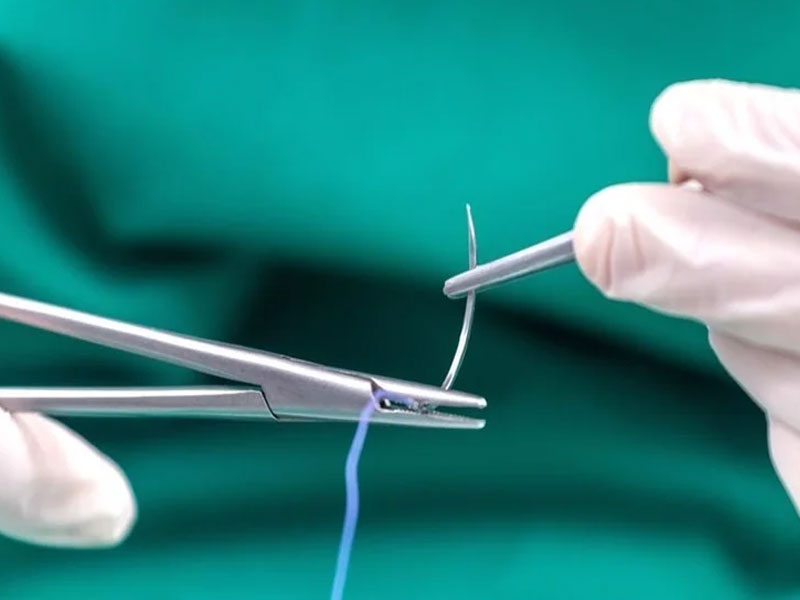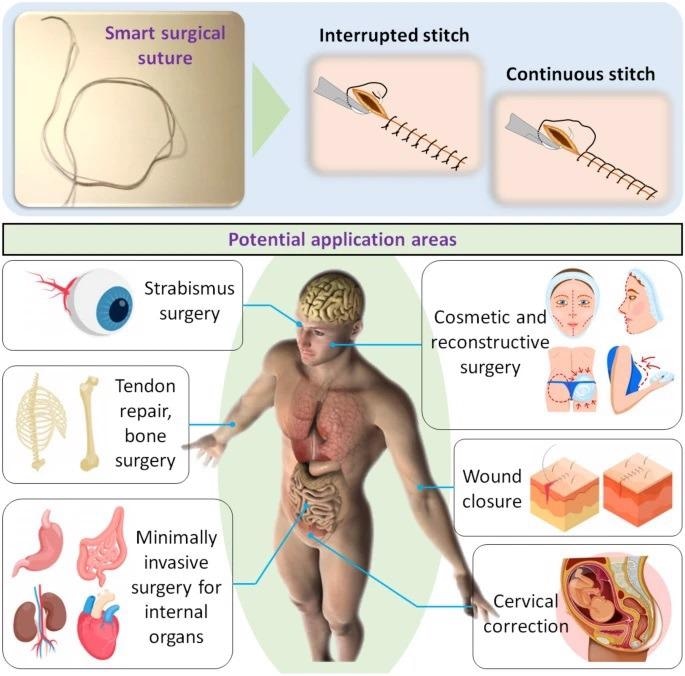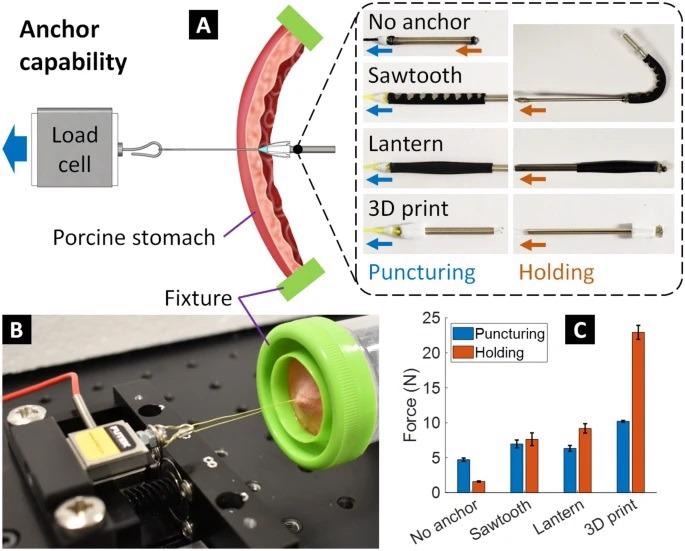Amazon Astro offers security monitoring for small businesses
SOURCE: HTTPS://WWW.THEROBOTREPORT.COM/
NOV 16, 2023
Using Soft Robotics to Perform Sutures
SOURCE: AZOM.COM
NOV 26, 2021

Wound closure is a technique for speeding up the repair of faulty tissue at a surgical site. Surgery sutures with new soft artificial muscles are beneficial for medical procedures because they help wounds heal quicker by joining tissue and forming microscopic scars, as stated in the journal Nature.
The optimal suture should have appropriate mechanical strength and homogeneous tension application, as well as the flexibility to allow for reduced suturing complexities during surgery, in order to accomplish exact wound closure for the recovery process.

Smart surgical sutures with two typical surgical stitches and their potential application areas. The pictures of strabismus surgery, tendon repair, bone surgery, minimally invasive surgery for internal organs, cosmetic and reconstructive surgery, wound closure, and cervical corrections were “Designed by Freepik”. Image Credit: Phan, P., et al., Nature
Nevertheless, none of the currently available commercialized sutures can meet all of these criteria. Despite advancements, no one material can suit all surgical needs. Suture fibers for wound closure are determined by various aspects, including tissue layers, tissue type, tension, surgical approach, and removal time. Suture materials such as nonabsorbable and absorbable materials are used depending on the kind of wound closure.
For flexible endoscopic procedures, wound closure using surgical sutures is a major difficulty.
Significant attempts have been made to produce smart and practical surgical sutures that can also monitor wound status or simplify knot tying. Despite soft robotic systems having sparked the popularity of smart sutures for years, developing a soft robotic structure that has a comparable physical structure to traditional sutures while also providing a self-tightening knot or anchor to heal the wound is difficult.

Fabrication, working concept, and prototypes. (A) (i) S2 suture-anchor with 3D printed anchors at the initial phase (no pressure). (ii) Completed S2 suture-anchor with pressurized artificial muscle. (iii) Making stitches through tissue. (iv) Tightening the suture and tissue by releasing pressure. (B) Deployment of the lantern and sawtooth anchors after releasing the pressure. (C) S2 suture-anchor prototypes made from STAM, three types of anchors, and commercial surgical needles (details in Table 1). (D) Wound closure procedure using dual surgical robotic arms with continuous stitches of the S2 suture-knot. (E) An S2 suture-knot prototype at high and low pressure. Image Credit: Phan, P., et al., Nature
The capability to use a thread-based qualified medical suture in three dimensions in a vital organ context offers a unique capability that the other flexible monitoring platforms lack.
Traditional surgical sutures can be improved by combining sophisticated composite materials and innovative products with improved mechanical qualities. Whereas most medical sutures for wound closure need safe knot tying with adequate strength and required compression to unite separated tissues, making a suitable knot with adequate tension during the bandaging process is difficult. Traditional smooth sutures have been improved to barbed sutures that self-anchor to organs, removing the use of a knot.
A novel generation of smart surgical sutures which can autonomously tighten deficient tissues with regulated tension while providing uniform force distribution inside the tissues without requiring human interaction is desperately needed.
The researcher made a proof that derives from a concept for a new smart surgical suture (S2 suture) built from a soft hydraulically artificial muscle. The soft, extensible, and flexible is key of new technology using artificial muscle is a tendon-like artificial muscle (STAM).
To summarize, this soft hydraulic artificial muscle absorbs incoming fluid pressure to lengthen to the desired length, collects prospective elastic energy, and then creates contraction force before reverting to its original form when the pressure is released.
It has a high elongation rate, a large length-to-diameter ratio, downsizing potential, and the capacity to alter its starting stiffness or produced contraction force. The STAM may be used for a variety of smart suture applications due to the plentiful availability of biocompatible microtubule and micro-coil material and the easy construction procedure.

Anchor capability. (A) Experimental diagram to measure the puncturing and holding force of different types of anchors through the real porcine stomach tissue (~?3 mm thickness). (B) Actual experimental setup. (C) Experimental results. Image Credit: Phan, P., et al., Nature
The S2 suture may alter its length to obtain the correct tension at the moment of fabrication and mechanically tighten its knots or deploy anchoring to secure the suture against the stitched tissues without requiring any external pulling power, as is the case with traditional sutures. In particular, the S2 sutures come with a variety of anchors that may successfully fix the defect materials without the use of knots, giving you a variety of options to fulfill your wound closure needs.
The STAM is an elastic, flexible, soft artificial muscle formed from a micro-coil and small soft silicone tubes that may be stretched to hold elastic energy during hydraulic pressure and produce contraction power when the tension is reduced.
Both sides of the STAM are fitted with securing anchoring in the S2 suture-anchor combination. Such anchors may be deployed automatically to fix the material without need for a surgical knot, which necessitates sophisticated closure device management. A PLM is linked to one endpoint of the STAM to hold and relieve its pressure. The STAM's other end is attached to a curved surgical needle and a cone-shaped suture tip.
The S2 sutures were created in such a way that they may deliver a desirable tension force that is neither too loose nor too tight. Before reattaching, the S2 sutures have been pressurized up to a specific initial elongation, that also corresponds to ultimate tension once pressure is reduced, and the surgeons will undertake a closure operation with stitching, in which a high pre-tension for the soft intelligent suture (which itself is widely supported in current surgical sutures) also isn't needed before safeguarding.
The precise ultimate tension of the S2 sutures was significantly reliant on the sewing abilities of the surgeons.
LATEST NEWS
Augmented Reality
Hi-tech smart glasses connecting rural and remote aged care residents to clinicians
NOV 20, 2023
WHAT'S TRENDING


Data Science
5 Imaginative Data Science Projects That Can Make Your Portfolio Stand Out
OCT 05, 2022

SOURCE: HTTPS://WWW.THEROBOTREPORT.COM/
NOV 16, 2023
SOURCE: HTTPS://WWW.OPP.TODAY/
NOV 01, 2023
SOURCE: HTTPS://WWW.THEROBOTREPORT.COM/
OCT 02, 2023
SOURCE: HTTPS://WWW.SCIENCEDAILY.COM/
SEP 13, 2023
SOURCE: HTTPS://WWW.SMART-ENERGY.COM/
AUG 28, 2023
SOURCE: HTTPS://WWW.SCIENCEDAILY.COM/
AUG 22, 2023
SOURCE: HTTPS://WWW.SCIENCEDAILY.COM/
AUG 10, 2023